
The Saints' Way, Cornwall
Leg One: Padstow to Little Petherick
The Saints' Way is an ancient pilgrim and trading route which crosses the breadth of Cornwall from the north coast at Padstow to the south coast at Fowey. It was used to avoid the treacherous waters around Land's End for people travelling from Wales and Ireland onto France. In modern times a path has been created following much of the original route and incorporating places of historical and ancient interest, including sites associated with Celtic saints.
The path starts in the ancient harbour town of Padstow (Petrocstowe) where St Petroc founded his original prayer site and monastery before moving inland to Bodmin. You can read more on the St Petroc pages on this site. We started the first short section of the walk at Prideaux Place on the outskirts of Padstow. There are two ancient holy wells here, one associated with St Petroc and visited previously. The deer in the deerpark were a beautiful sight as we set off downhill towards St Petroc's church.

Walking into the churchyard I was immediately transported into the hush of a holy place, despite the busyness of the surrounding town. It feels a timeless place where you want to slow down and linger. Entering the church, the atmosphere only intensified. So praying in the side chapel set aside for prayer, we lingered in God's companiable presence.

he Saints' Way officially starts at the church. Take time to notice the ancient Celtic cross in the churchyard before heading out and up an ancient stone walled, moss clad lane which feels very old. It leads away from the church and shortly you're in the suburbs of the modern town walking among buildings but with tantalising glimpses of the sea and Camel estuary.


Before long the clearly marked signs point you to another ancient path leading down towards a marshy creek and then up towards an obelisk on a hilltop surrounded by fields. The views become more open with vast skyscapes with the sea spread out before you, rolling green hills dotted with sheep and the wide spread of the Camel Estuary.

We paused on the hill top to take in the beauty, to try to imagine what it looked like for Petroc walking this route. No doubt the hills were wooded rather than fields but the sea and estuary might have looked somewhat similar. He might only have been able to glimpse the water and not have the wide vistas we enjoy today.
We were walking in April and the meadows were full of buttercups and the woods of bluebells, ramsons and the occasional orchid.

We lost the route a little near the obelisk, veering too far inland and ended up the wrong side of a sweeping buttercup clad field with horses. However, we could see Little Petherick Creek and knew we needed to head down to it, so cross the field and in the boundary were able to pick up the path again. Looking back we could see there was a walked path across the meadow, with the obelisk to the right.
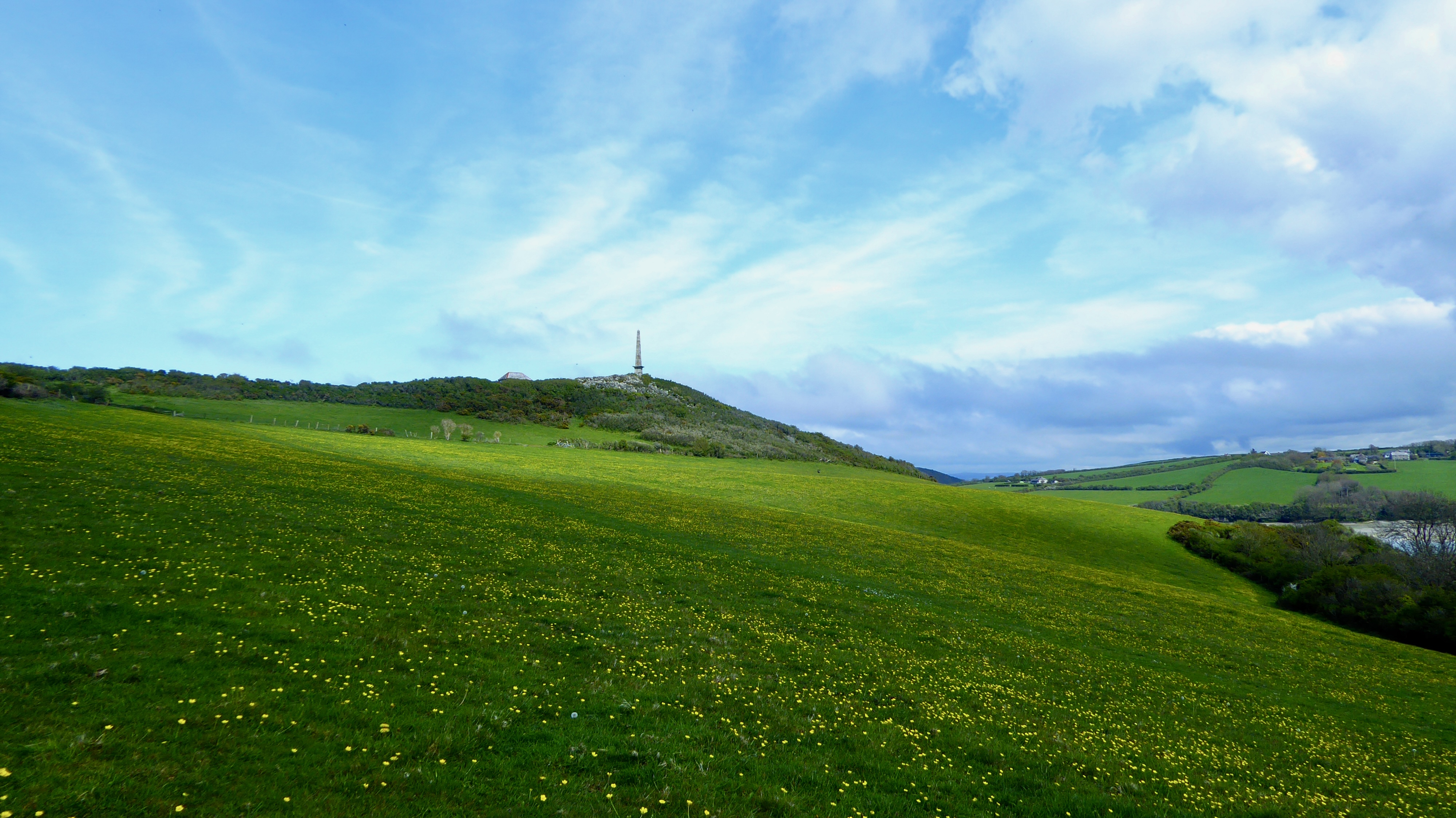
Leaving the wide sweep of the meadow behind we entered a secret wooded path where the trees almost wrapped around us. Swathes of bluebells filled the wood floor as the path meandered downwards and then rose up a steep hill. Suddenly we were in field upon field of blooming daffodils. It was a delightful sight, very cheerful and welcoming. We stopped to enjoy them before walking on towards a marshy creek where we stopped for a cuppa, soaking in the surroundings and peace of the path.
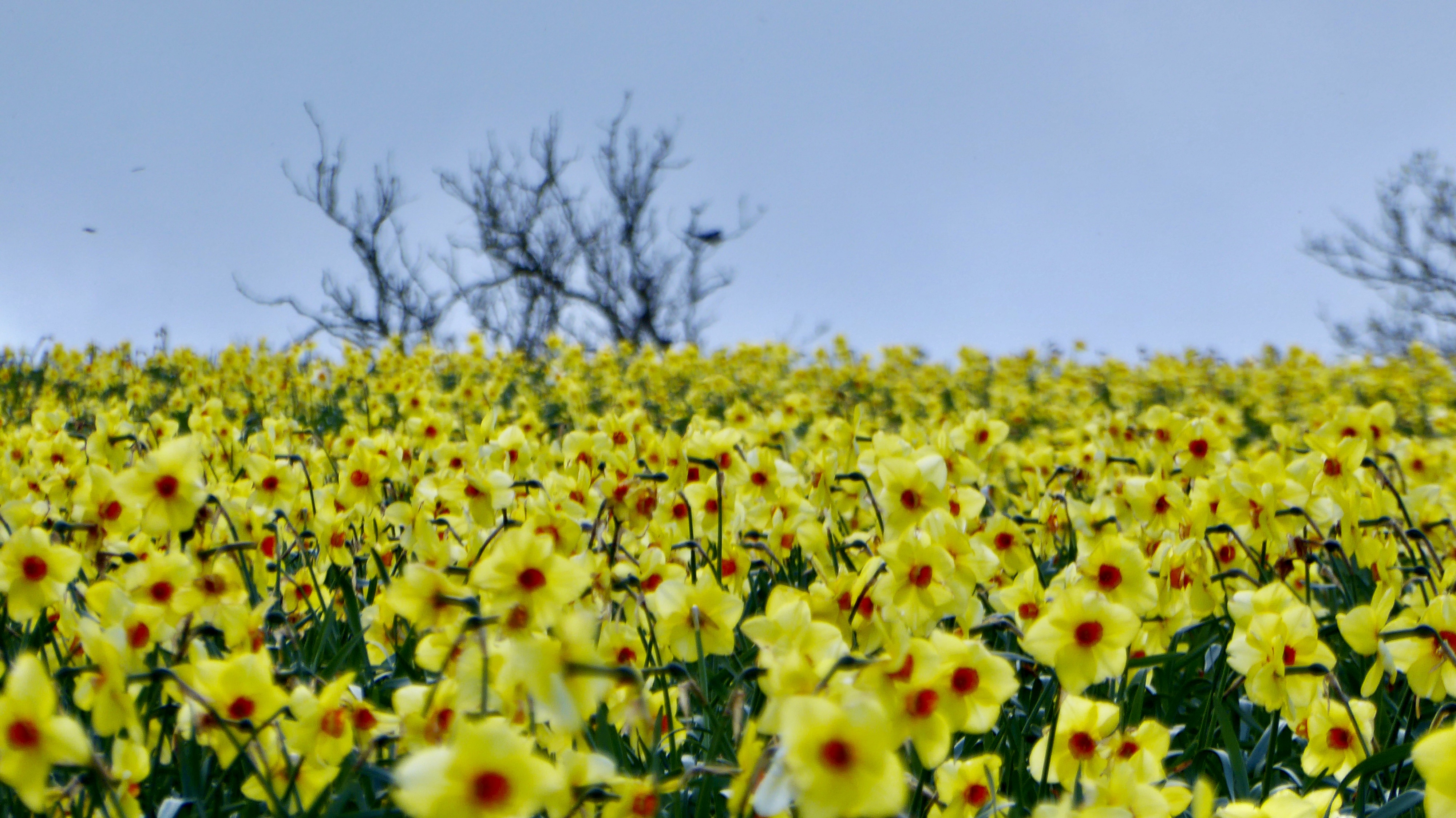
Throughout this part of the walk there are magnificent views looking down Little Petherick Creek. It was low tide and the old fish tidal ponds were clearly visible.

Moving on from the marshy creek the path once more feels very ancient, a small snaking line through deep undergrowth and a canopy of trees. Each step becomes more measured and a pace sets in which leaves behind the relentlessness of modern life. Pilgrimage begins to seep into the soul and a dwelling on inner thoughts, a peacefulness, a walking time of contemplation. The woods block views of the river at this point and you find yourself walking in step with those inner thoughts, living in the moment.

The path eventually drops down to the creek and the remains of St Petroc's Well are ahead of you on the right. They are sadly neglected and uncared about.

Walking now on paved road you soon reach the main road through Little Petherick with the church of St Petroc Minor on your right. This is definitely worth a visit for the astounding artwork displayed in the carved rood screen and the elaborate decoration. I particularly love the angel depictions.
So we ended this part of the actual walk here, praying in the church before catching a bus from the bridge back into Padstow.
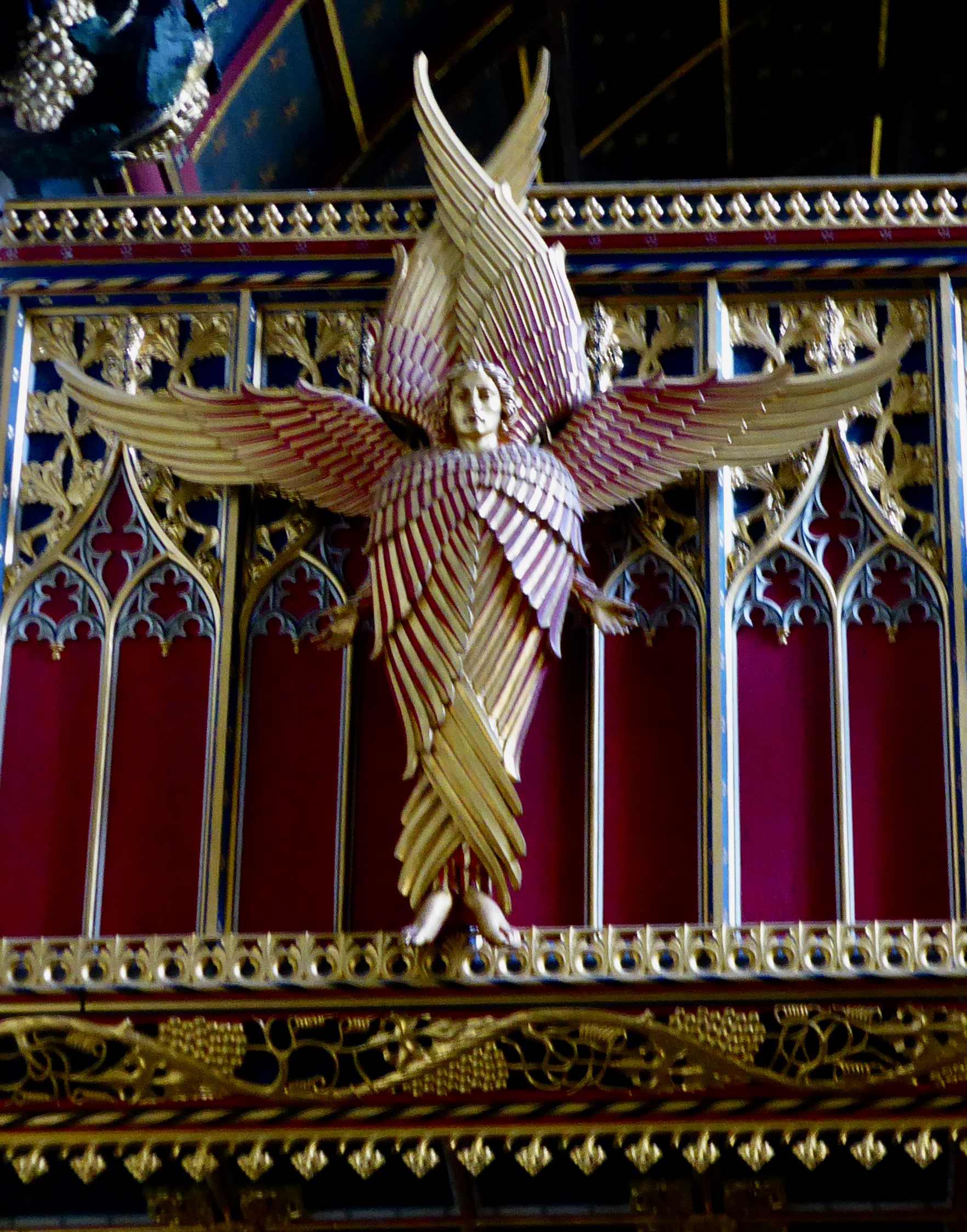
I can't say I had any special revelation from God during this leg of the walk, however, the awareness of God's presence in St Petroc's church in Padstow was so strong and so reminiscent of the atmosphere at St Illtud's church in Llantwit Major, that you know these were very special people of God who laboured here in centuries gone by and who prayed for the land, the county and the people following on behind them. Perhaps some of those prayers are waiting to be answered in our generation for the land of Cornwall and beyond.
Leg Two: The Saints’ Way, Cornwall: Little Petherick to St Breock Downs
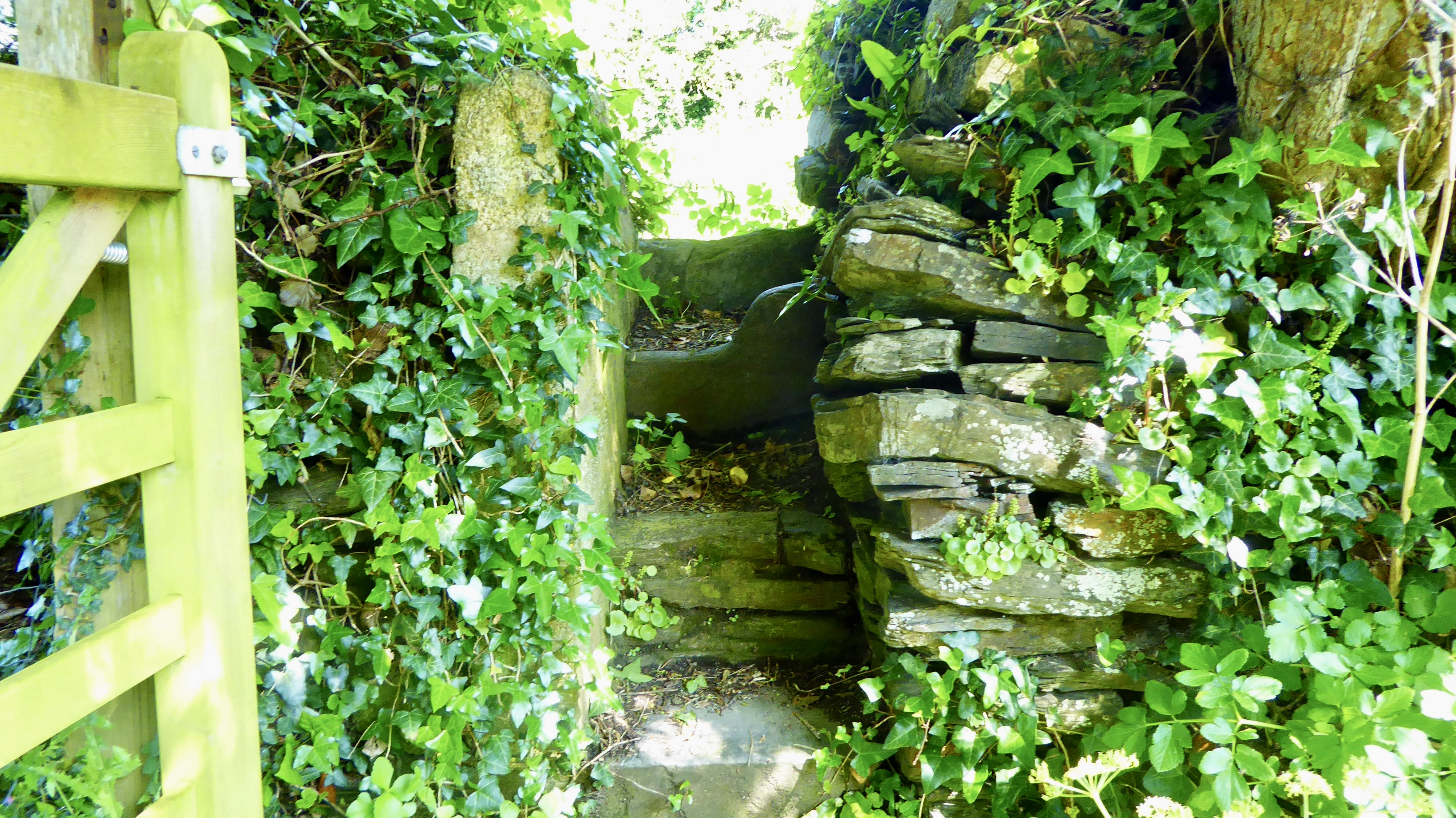
Having walked from Padstow to Little Petherick in our first excursion along The Saints’ Way, we continued with the second leg by starting at Little Petherick.
Be warned, it’s a very busy road. We parked in the carpark by the church and village hall which entails crossing the road and walking over the bridge to pick up The Saints’ Way. The path follows the road, only for a very short way, but the traffic comes scarily fast. It was a relief to pick up the footpath off to the right and breath again.
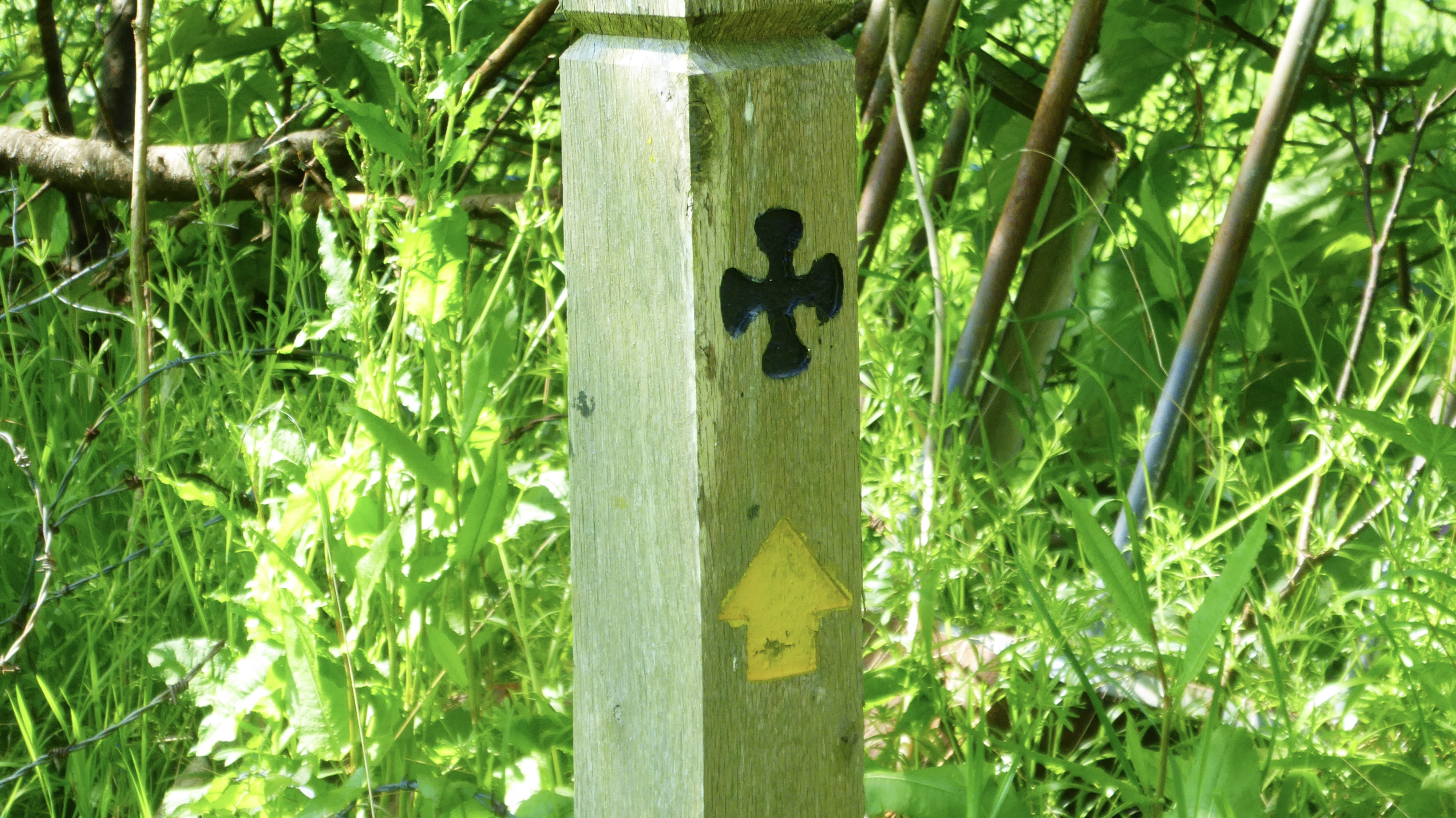
We were walking in May and recent rain followed by warm sunshine had caused all the wild flowers to whoosh up and froth along the sides of the ancient lane we found ourselves on. It was beautiful. This part of the walk was a delight. You could feel we were walking in ancient footsteps, the path nestled between old Cornish hedges of stone. At times we found ourselves just stopping to marvel at the beauty of God’s lavish flower gardens: frothy cow parsley, angelica, red campion, stitchwort, bluebells, May blossom, buttercups, dog roses and everywhere that bright, vivid green which radiates life when the first leaves burst open. The grass was long and several butterflies flitted contentedly along the verges; speckled brown, orange tip and red admirals.

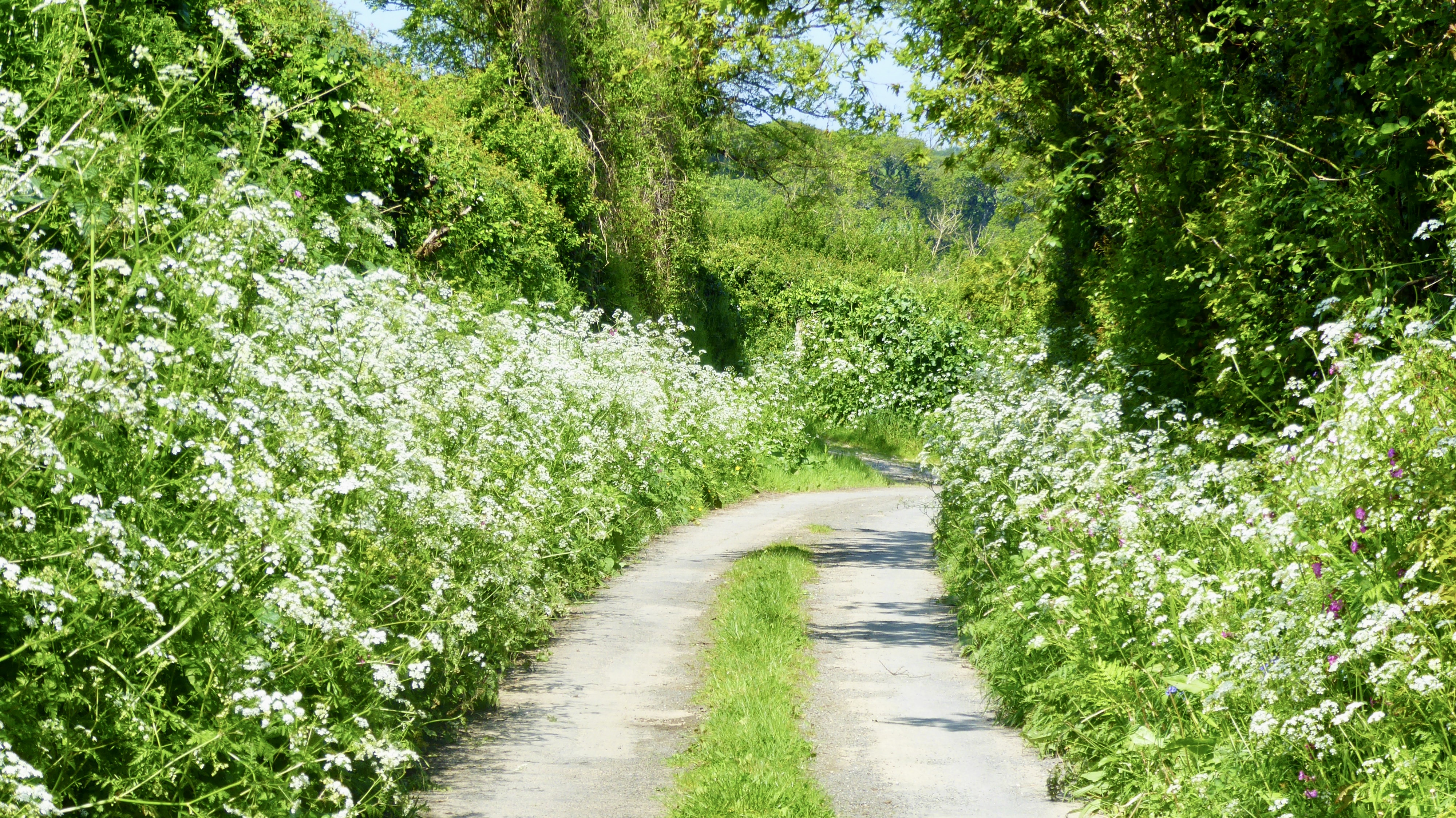
Having passed through the hamlet of Mellingey, seeing the old mill, we followed the quiet lane up the hill to Trenance where we once more picked up the ancient green lane. This was our favourite part of the walk. My husband and I found ourselves walking separately, communing with God individually. Everywhere we looked was beautiful, peaceful, a delight. There was no human noise and it was like stepping out of time and in step with God. I held back from my husband, as I sensed God speaking and as I did, I began to walk in step with him.

‘Walk slowly with me down the ancient lane, step by step, slowing down.
Breathe. Stop. Listen.
Walk on tuning out the clamour of man, tuning in to the creation of God.
Slow down with me. Step in step. In step with your spirit and the Spirit of God.
Feel the breeze cooling the forehead. Hear the singing birds proclaiming in every hedgerow; blackbirds calling the song of May; swallows skimming low; wren trilling.
Slow. Pause. Breathe. Slow down.
Come with me on this walk down the ancient paths, brimming with cow parsley, red campion, buttercups nodding and bluebells – the air filled with the scent of early summer. Hush.
Think back down the ages who has walked this path. (Did the ancient Christians tread this way? Petroc himself? Guryon?)
Step by step, slowing down, enjoying the journey, taking time to stop along the way to notice the detail, to linger, to enjoy the glory of God expressed through beauty in creation, to marvel at the wonders of colour and form.
Sensing the sounds, the taste of nectar in the air, the humming of insects. Slow down with me and breathe in the life of God.
Not asking. Not thinking, just dwelling in the moment of peace and beauty. Stepping outside of time.
Time has no rush, no limits, just step by step in step with God along the ancient path.’
So I found myself walking alone, even without the dog who had gone ahead with my husband. It was such a companionable time walking with God, noticing what he pointed out, sharing that joy of communion together. I tuned in deeply to the things of God with a deep resonating joy. It reminded me of a walk decades ago when I lived in Devon and was ambling down another ancient path. I crossed to look closely at a tiny violet nestled in the hedge. I remember God’s voice clearly from that day, ‘Thank you for noticing’. We forget that he created this beauty of the natural world for our enjoyment and benefit. He put much thought into the design, to display his glory, to bring joy to our hearts through his lavishness and care. It means something to him when we notice and are grateful.

As we moved out of this beautiful lane, into a steep meadow full of sheep leading down to a water meadow and brook we didn’t know we were leaving behind the best part of this section of the walk.

I’m glad we took the time to linger and sense the ancient path because from then on upwards to St Breock Downs took a bit of grit and determination. I cannot help but notice the contrasts – the ancient way with hardly a finger print of man juxtaposed to intensive farming which feels like a rape of the land. The lavishness of God’s creation and the ugliness of man’s interventions.
The path was soon crossing intensively cultivated fields with hedgerows removed, no sign of wild flowers, or insects and a certain chill in the air despite the hot sun. The walk was uphill for several miles and a bit of a slog. Thankfully, in these wide open fields we heard skylarks and several flew up singing overhead. The views were expansive too and you could see for miles – yet I found the ancientness had disappeared and so had that intimacy of walking closely with an awareness of God.


However, there were delightful highlights. We bumped into another person who walks pilgrimages visiting ancient Christian heritage sites – Anne Hayward. Look her up on www.pilgrimstreet.com to read about the fascinating long distance pilgrimages she walks. I’d read one of her books, A Celtic Pilgrimage, so it was great to meet. She was four weeks into a six week pilgrimage and heading that day to Padstow. We chatted, shared and prayed blessings on each other as we went in opposite directions.

Further on we caught up with a party of year 4 school children and their teachers who were walking The Saints’ Way together. Their delightful chatter kept us going across a rather dreary section of the path, which still headed uphill. They loved our dog and were a bit astonished that she, at 9 ½, was older than most of these young 8 year olds. In that brief chatter I discovered different nationalities and cultures: Portuguese, Australian, Ukranian and Jewish. The children were representing 22 different schools from across Cornwall and were walking the route as part of understanding different religious cultures. I was able to tell them about why the route was called The Saints’ Way and share a little about St Petroc with a couple of them.
We parted company at a huge standing monolith another sign that these downs were once more populated.
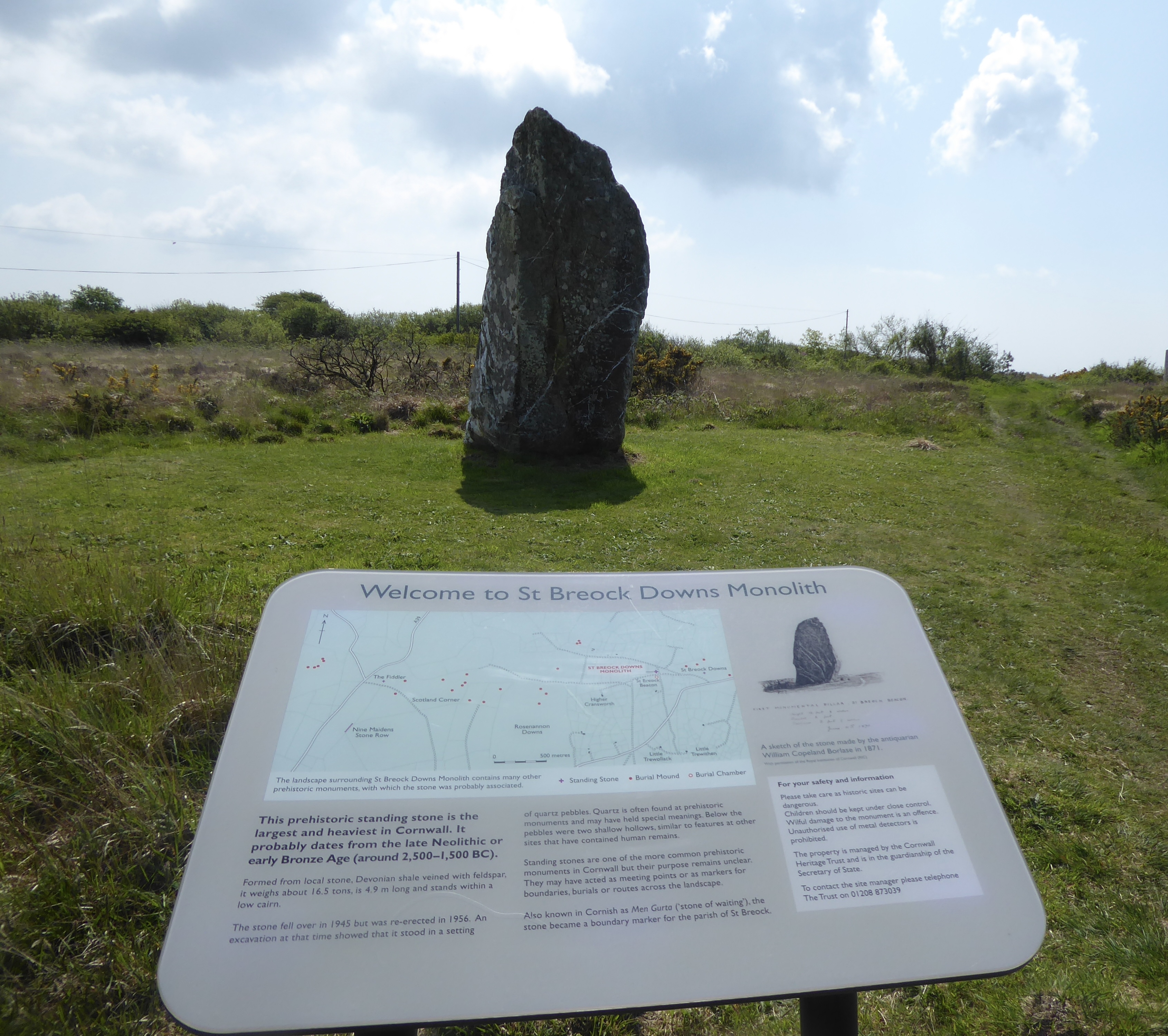
As we walked the final mile we had views right across St Breock Downs towards the wind farms near Wadebridge and in the other direction the hills of china clay country above St Austell. It was easy to see how high we had climbed from the coast and that we were now on the inland moors of Cornwall’s higher interior. It was a deliciously hot spring day but in winter the mizzle (mix of soft rain and mist) often lingers here inhospitably. It must have been hard for travellers with no shelter nearby on such days.

We ended this section at Hustyns Complex and were relieved to be able to get a drink and put our feet up before deciding how to actually get back to our car!

Leg Three: Hustyns to Withiel

After the long slog of the last section, we decided to do a much shorter walk for leg three dropping down from Hustyns across fields into the River Ruthern valley and up the other side to Withiel.
This was an interesting walk with sparks of sheer beauty. We walked it in June and to be honest the first section from Hustyns until we picked up the trail across fields was challenging. The road we walk along was busy, not just with cars and white vans but huge tractors and grass cutters as the farmers were bringing in the hay. At times it was quite terrifying as these vehicles thundered by and we held the dog tightly. I also managed to take a tumble in the road, tripping over the dog and smashing face down onto the tarmac. My husband says my angel was working overtime as miraculously I sustained no major injury, just minor grazing and so we carried on with the walk.
Why even mention this? It made me ponder on the dangers we were facing as 21st century pilgrims traversing the county and pondering the dangers faced by the earlier pilgrims. What dangers did they face? Wild animals: wolves, boar, bears? If they fell and broke bones there was no access to doctors or hospitals. Thieves and rogues? The lanes are often enclosed, passing through dense undergrowth hiding dangers of many kinds and of course the weather. We travelled on a glorious June summer day. The ground underfoot was dry and easy walking but at one point we passed a deep gorge with a tiny tricking stream running through it. In winter it must be like a wadi, containing flood water pouring down at force to have created the deep sided cutting. I concluded these travellers were made of tough stuff, brave, courageous, faith filled. Today the path is sometimes quite hard to find. Was it clearer in their day? Did the hooves of donkeys keep the vegetation down? Was the track obvious? I think it must have been. Of course the field system wasn’t there, and the scenery would have looked greatly different probably more wooded, so it makes sense that such a well trodden route would have been way marked clearly.

Once we left the busy road and started crossing fields with stock, the walk became far more enjoyable. The skyscapes are vast at this point, and you seem more aware of the sky arching above than the land beneath but this soon changes as you begin to drop down towards the River Ruthern valley. The ancient track is enclosed between high wooded hedges only allowing glimpses of the fields and distance views. At one point you can see Withiel church, the end point for our walk today. It seems at a great distance but is actually under two miles.
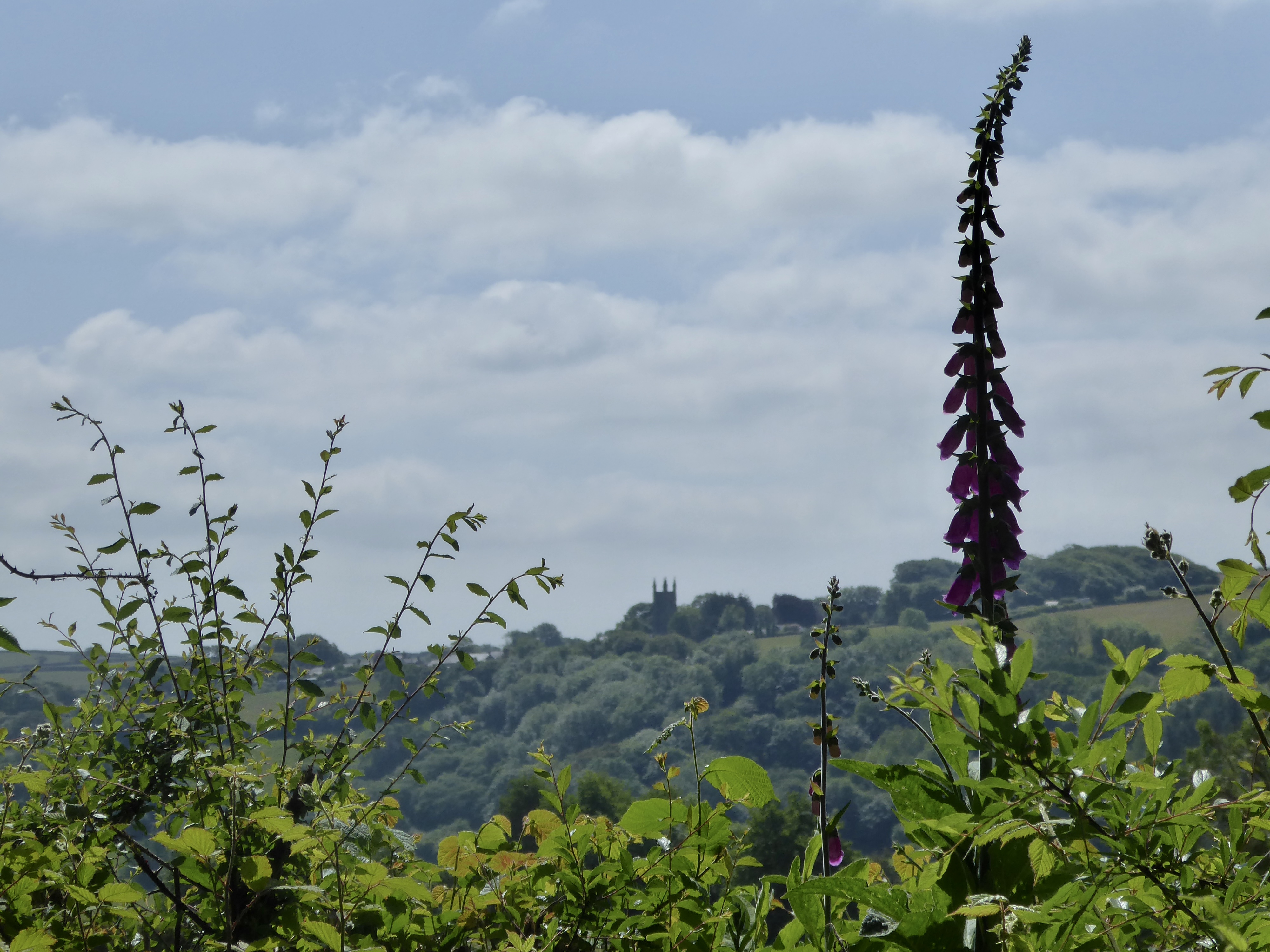
The Ruthern valley is beautiful, very wooded with water meadows running along the stream. It is quintessential sylvan English countryside. The birds sing and the lane is flanked by an abundance of wildflowers of all colours. Clouds of cow parsley, field buttercups, May blossom, red campion, purple foxgloves and wild honeysuckle cause us to stop, stare, admire and enjoy. This is God’s garden, lavish and delightful.

We follow the lane into a small hamlet, turning right onto a narrow road before picking up the path over more fields and down to the river crossing. There’s a ford and footbridge over this shaded spot where we rested and enjoyed the cool before embarking on the steep climb up to Withiel.
The track is good underfoot and from here on easy to follow, leading directly to Withiel church. However, it is a steep track for this section which has its benefits. As we stopped to get our breath we noticed details such as amusing trees with faces, or distant views glimpsed at farm gates. I found this the prettiest part of the walk.


Once at Withiel church we paused to pray inside. It’s a pretty church and clearly loved. There’s no mention of a Celtic connection however the churchyard is raised and curved in parts which suggests to me it is earlier in origin than the present medieval church. It is dedicated to St Clement who isn’t a Celtic saint.
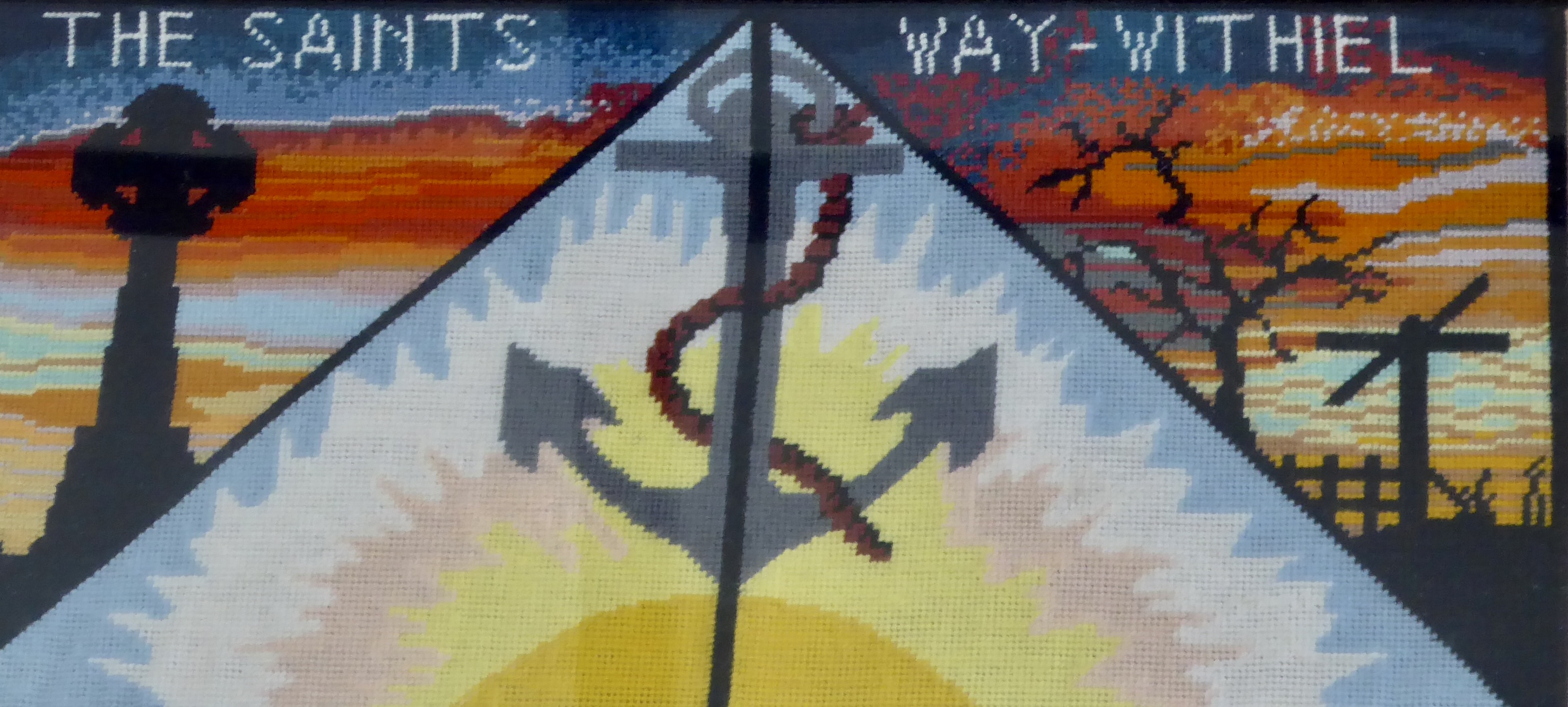
There was no immediate tangible presence of God, unlike other places we’ve visited, but we still worshipped and sensed His peace descend. We left blessing the people who worship here, the vicars who minister and those who live in the area.
To be continued......